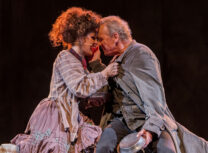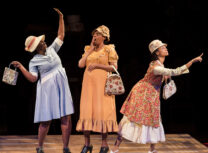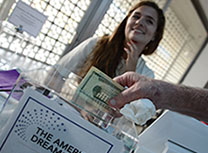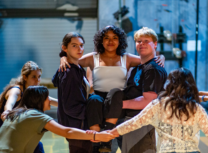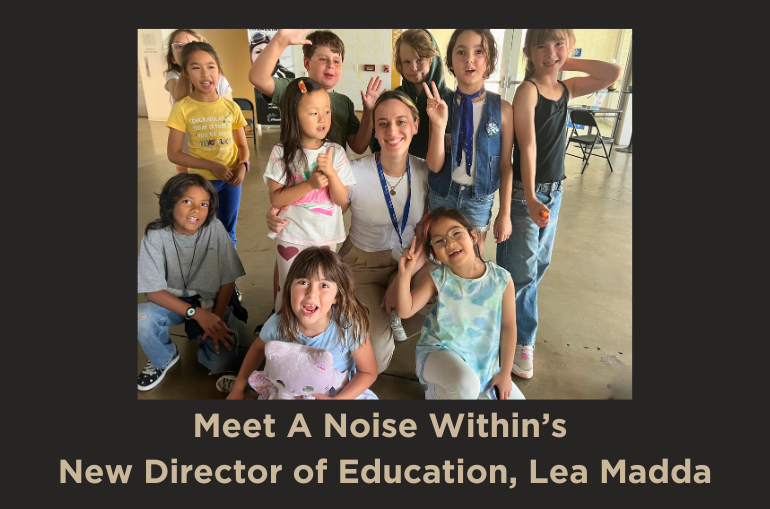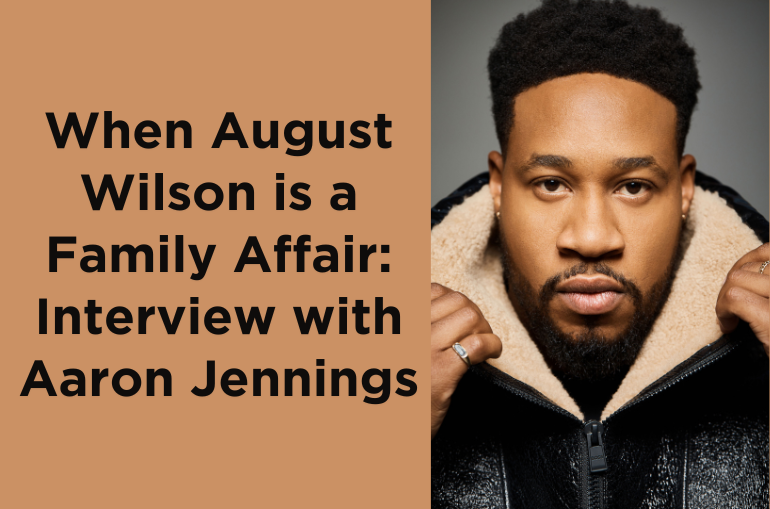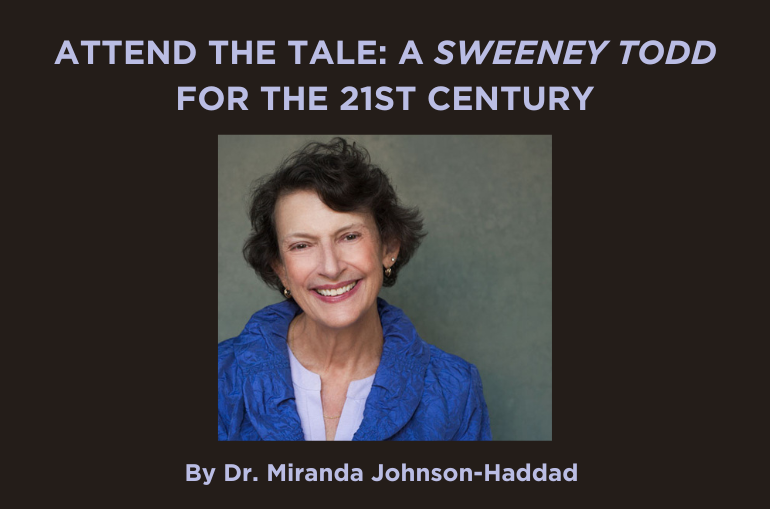The Women of Shakespeare Q&A
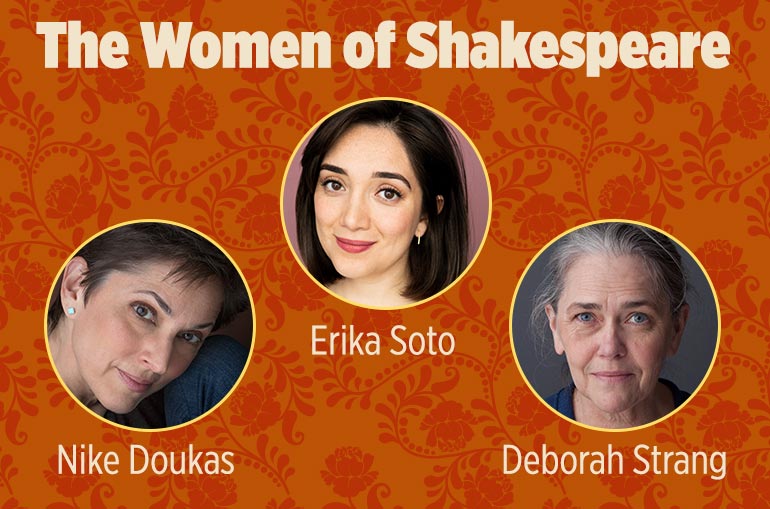
By A Noise Within
February 2, 2022
Who better to talk to about the world-shaking women in All’s Well That Ends Well than to talk to the women in our production! Enjoy insight from Director Nike Doukas (she/her) and Resident Artists Erika Soto (she/her) and Deborah Strang (she/her), who play Helen and the Countess of Rosillion, respectively.
What does women empowerment look like for Helen over the course of her story? What about other female characters?
Nike: Like many of Shakespeare’s heroines, Helen vacillates between doubt in herself and her great need to make change in her life. For me, Helen’s empowerment comes from her journey—both physical and emotional. In each of these journeys or “tests,” she prevails. She takes enormous risks and the risks pay off, and as time passes, you see her get wiser and more mature and more forgiving of herself. What never shifts is that fact that she is a doer. She sets most of the plot in motion. She just can’t help that part of herself, the part that can’t settle for anything less than what will bring her happiness.
Erika: Taking up space. Demanding what she wants. Fighting for what she wants. Challenging the social and cultural structures built to limit and box her in. Saying no surrender or failure.
Deborah: The Countess begins the play with grief and loss—over her husband’s death and the departure of her son to serve in the King’s court. As the play progresses, the Countess begins to trust her mind and heart and to make her own decisions regarding not only her household, but also the societal norms in her community. Her generous world view helps her empower Helen to take control of her own future.
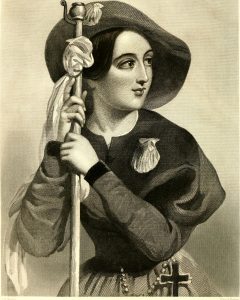
This play features a strong community of women, particularly with the clown Lavatch being played by a female. How do women show up and support one another in this play?
Nike: There are so many instances of the importance of community in All’s Well and how people need community to achieve goals. Though the Countess may initially be worried about Helen’s plan to win Bertram, Helen’s passion, bravery, and inventiveness win the Countess over. She advocates for Helen at every turn. The Widow and Diana are another example, and maybe an even more striking one, since they’re strangers to Helen. Helen’s generosity, her deep care and interest in Diana’s welfare, and her boldness inspire the Widow and Diana to help. By the play’s end, their friendship feels deep. There is such kindness and caring in this play!
We have two male roles that are played by women; I wanted the Countess’ estate to be filled with women because it helps tell Bertram’s story of needing to escape to the court and war—all those traditionally “male” adventures. Sometimes changing the casting highlights a new aspect to the role or the relationships in revealing and surprising ways. Here, Rinaldo (now Rinalda) is the Countess’ close assistant, and having two women working together creates a very different dynamic than had we have a man play that role. The same is even more true for Lavatch. During rehearsals, one of our actors, Kasey Mahaffy (who has played many clowns), observed how refreshing it was to get to see the woman be the funny one who makes the bawdy jokes. I think it both expands our sense of what’s possible and confirms what we already know to be true: that we are more alike than we sometimes imagine we are.
Erika: The women in this play are FANTASTIC. They are so much like the women I am lucky to have in my life now: supportive, empathetic, understanding, cheerleading, loving. The Countess believes in and helps Helen embark on a risky adventure. Helen relies on the Countess for protection and validation and loves her as a mother. The trio of women in Italy are all protective and caring of each other. And when Helen arrives, they support her in achieving her goals at great risk. There is no competition or animosity. There is just a circle of camaraderie, gutsiness, love, and support.
Deborah: The Countess’ husband has died recently, and we now see her running the household and doing a fine job of it even though it is a new position for her. Lavatch and Rinalda are her two oldest and closest companions. I love seeing how personal those relationships are. Even when the Countess is focused firmly on the situation at hand, Lavatch finds a way to distract her and help her find levity in the midst of grief. Lavatch refers to herself as a prophet, and indeed her merriment on marriage and finding “friends” to satisfy her future husband foretell the situation that Helen will soon find herself in. The relationship with Rinalda can be exasperating for the Countess, yet their friction feels more like the bickering of an old, comfortable married couple than a major rift. The Countess knows that Rinalda can be counted on in any situation—she is truly the Countess’ right-hand person.
Marjorie Garber, author of Shakespeare and Modern Culture, said of All’s Well That Ends Well: “It contains not one but two roles that would make an actress’s career (and have). Both Helen and the Countess are brilliant, complicated, strong women who, finding themselves in impossible situations, emerge not only whole but triumphant.”
What are your thoughts on Marjorie Garber’s comments about your character?
Erika: I couldn’t agree more! This role is a transition for me as an artist as well, and that journey is reflected in Helen’s. She recognizes what she wants, struggles with her sense of limitations, fights against them, takes matters into her own hands, challenges the social and cultural norms of her world, demands her desires, makes magic. Ultimately, she gets what she wants. That is all INCREDIBLY powerful.
Deborah: I love this quote. And in Nike’s casting, the quote can be extended to the Countess’ entire household as both the Clown and Rinaldo (Rinalda) are also women. And beyond to Italy, where the Widow, and Diana, and Mariana form a strong community of women. All of these women work together to bring this play to a triumphant conclusion. Shakespeare so frequently presents us with single fathers and missing mothers, so I find it very relevant that this play is a journey away from the paternal, war-driven world of men and death and instead toward a maternal world of rebirth, community, forgiveness, and redemption.
How will this production approach the relationship between Helen and Bertram, particularly in terms of gender and class politics?
Nike: I believe that Shakespeare loved and respected women: their intelligence, their wit, their bravery, and their ability to make change. He recognized that the world wasn’t equitable, and that women were, by society’s mandates, subservient to men. I do think he saw them as vanguards of a spiritual superiority (there’s a great book about this by Marilyn French called Shakespeare’s Division of Experience). In All’s Well, Helen thrillingly proves that she’s capable of moving through a male-dominated world (spoiler alert!). She shows up uninvited to the King’s court and offers to cure the dying King, and in return she asks to choose her own husband. Shakespeare inverts the traditional fairy tale model, where we would expect the male character to embark on that kind of quest. Also breaking the expected model is Bertram, who’s continually running from Helen. He’s ever in pursuit of new experiences at the Court, in war, and in the bedroom. We only see the two together alone once, briefly, in the middle of the play. I think they each have to learn something about themselves, alone, before either become truly ready for the other.
Erika: Helen and Bertram are seen as having grown up together. Helen, of course, has developed a deep love for Bertram and he—maybe not obviously at first—also cares for her. The difference is that their status makes Helen invisible to Bertram as a woman. I think her not coming from noble blood has a lot to do with this and is why the King plays such a major role in creating her status through association and material wealth. Ultimately, I think Helen gains Bertram’s appreciation and respect through having been so self-accomplished by traversing and overcoming every obstacle along the way. So, we see her fight to earn his love through merit, honor, and wealth, and him resist because of class, position, and status. In the end, they come together after surrendering to their genuine affection and admiration.
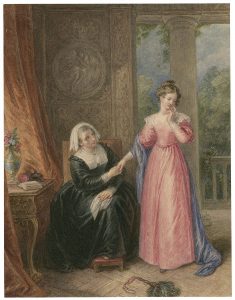
How does the Countess’ relationship with Helen compare to her relationship with Bertram?
Deborah: The Countess even speaks to this directly in the play: “Which of them both is dearest to me, I have no skill in sense to make distinction.” Helen did not “oppress me with a mother’s groans,” but the Countess loves her and cares for her as a daughter. When Bertram abandons his new wife and runs away to join the war, the Countess says to Helen, “He was my son, but I do wash his name out of my blood and thou art all my child.” And yet the Countess cannot stop trying to find a way to redeem her son, and she knows that redemption can only happen if she can bring Helen and Bertram back together. The Countess feels very modern to me—she recognizes that the class difference is an obstacle to the union, but she and Helen work together to find a way beyond their current social structures.
Galentine’s Day (February 13) is a day for celebrating female friendships, and serendipitously, All’s Well That Ends Well‘s opening weekend is Galentine’s weekend. How do or would you celebrate this holiday?
Nike: I didn’t know about this holiday! If it weren’t for Covid and distance, I’d be sharing it with my Galentine, Marcia Pizzo, one of my biggest champions, who, with my husband, Leo Marks, heads my “village” of support. I am blessed with a very big village of love.
Erika: Grab all my girlfriends, dress up, pile into a car, and go have dinner in the park with wine and bubbly. We go around and say what we are thankful for in each other, share how we want to continue to show up for ourselves, ask how we can show up for each other, and set a positive intention for the coming year!
Deborah: Every day is Galentine’s Day for me. I grew up with a strong, imaginative mother and three fascinating sisters. I was born celebrating the women in my life. This year I plan to celebrate the opening weekend of All’s Well That Ends Well with the entire cast and crew!
What’s it like working with fellow women in the cast, creative team, and crew?
Erika: Amazing. Nike is INCREDIBLY smart and hilarious. She’s specific and supportive, kind and direct. She has a way of letting you grow and evolve in your character while guiding you to tell the collective story. The women in the cast are beautiful souls as well. We’ve all become friends, and I’ve loved laughing and supporting each other through this process. There is a real sense of unity and bond with us—it’s amazing.
Deborah: Nike empowers the whole company just as the Countess empowers her household. She is incredibly smart, funny, open, collaborative, generous, exhilarating, and encouraging. We’ve known one another and worked together in various capacities for 30 years now, and I’ve always been a huge fan of her work. To have her as a director for the first time, and work with her now on this production is an honor. I can always count on ANW to bring together a strong team for each production, but this one is exceptionally talented—both old friends and fellow Resident Artists and Designers, as well as new cast members, and an astounding stage manager and crew that I hope to work with for many years to come.
Nike: From Julia Rodriguez, the Co-Artistic Director, who offers me invaluable insights and artistic and emotional support; to our Stage Management, who help me get through every rehearsal with grace; to our Dramaturg, who helps us all understand the play more deeply; to our Scenic, Costume and Wig & Make-Up Designers, who have provided us with glorious elements that enhance our storytelling; to our Production Manager, Backstage Crew and Technicians who and make sure all aspects of the rehearsals and performances are running perfectly; and finally to our seven women cast members who bring their inspiring artistry, we have a lot of women on board. (I haven’t even mentioned all the women in the office at A Noise Within, one of whom asked me to participate in this interview). It feels great to have all those positions filled by women. When we aim for an equitable ratio, we make sure that our storytelling reflects the complexity of the world we live in. I’ll add that this isn’t possible unless the men, who complement this ratio, have warmly embraced this ethos as well. Theatre (and life!) is a collaborative art, and only when we’re all sharing our perspectives can we aim for greatness.
